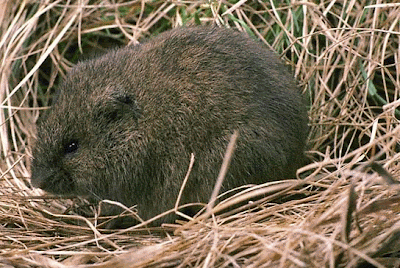Here's a YouTube video of a barred owl calling:
Barred owls are characterized by having brown eyes, no ear tufts, and horizontal bars on its neck and vertical bars on its belly. Typically about 20 inches tall, it's a predator of small mammals as well as being an opportunistic feeder that will take birds, large insects, amphibians, and even small reptiles. It's sometimes preyed on itself by the great horned owl and barred owls will generally avoid territories where they hunt.
It's not surprising to hear them near my house since I have a small meadow between my house and the road that's home to a lot of meadow voles (Microtus pennsylvanicus). This is also why I've seen coyotes in my front yard and hear them frequently.
Tasty little treats for those that silently swoop down in the night with sharp talons and beaks.
If you keep your eyes open next time you're hiking, you might spot an owl pellet at the base of a tree (I see them occasionally in the Shawangunks). They're elongate masses of matted hair that owls regurgitate after their meals and if you pull them apart you'll find fragile little rodent bones.
Last year, our whole family went to a program on owl pellets at the Mohonk Preserve and we each dissected a pellet. The kids and I got rodent bones but my wife had a whole bird skull in hers. Great fun!






No comments:
Post a Comment